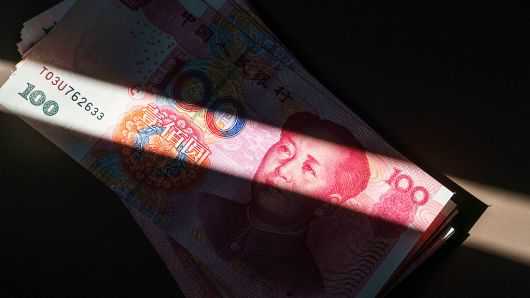For China, an intentional weakening of its currencywould be ill-timed
30 June, 2018

As trade tensions flare up between the U.S. and China, many investors are asking whether Beijing will look to weaken its own currency to retaliate against Washington tariffs.
The Chinese yuan, which trades in a band versus the dollar, has now weakened to its lowest level since December 20 and saw a daily loss of 0.3 percent on Thursday.
The trend lower has led many market participants to believe that Chinese policymakers may be paving the way toward a sustained depreciation, and that caution is warranted.
The weakening currency comes amid a slowing economic backdrop and a pickup in financial market volatility that has seen Chinese equities officially enter into bear territory this week.
This has prompted a policy response. On Sunday, the People's Bank of China (PBOC) announced it would lower its reserve requirement ratio (RRR) by 50 basis points. This cuts the amount of cash that some banks must keep in reserve, and is designed to help provide liquidity to small businesses. The cut in the ratio was the central bank's third in 2018.
The last few episodes of sustained yuan weakness, in summer 2015 and early 2016, also led to significant capital outflows, a seizing up of credit markets and a tightening of domestic financial conditions. It has taken years for these capital flows to stabilize.
But Morgan Stanley analysts highlighted in a research note last week that only in the last few months has there been capital flowing into China, rather than out of it. This coincided with the inclusion of about 200 Chinese stocks in the MSCI Emerging Markets index — a widely-traded index that can boost the credibility and liquidity of the stocks that it holds. Foreign investment accounts for only 2 percent of the total value of the domestic stock market in Beijing and it was seen as crucial for these firms to gain an international exposure.
Many analysts believe that, at this juncture, a stable currency that continues to attract capital inflows is more important to China.
Politically, it may not be in Beijing’s interests either. Analysts at political research firm Eurasia noted Wednesday that a strategy of weakening the yuan could also “cost China the opportunity to build alliances with other countries at the receiving end of U.S. tariffs.”
The vice president of the EU Commission, Jyrki Katainen, was in China last week and met with Vice Premier Liu He, with both sides issuing a statement agreeing to oppose protectionism. An intentional weakening of the currency would be ill-timed, though analysts have also noted that on a broader basis, the yuan is firmer for the year versus a basket of currencies (compared to other Asian and emerging market currencies which are all markedly lower).
So far, markets do not seem to be panicking. Chinese policymakers have typically used offshore interest rates to counter speculative investor flows in the currency, but as of yet the wedge between offshore and local interest rates has been stable.
Morgan Stanley analysts pointed to the difference between the current price of the yuan and what traders believe it will be in 12 months’ time. This “spread” has been stable suggesting that the market is not expecting a “significant or sustained yuan depreciation to occur,” the analysts said.
However, they cautioned that should that spread start to widen, the market could start to see pressure on other Asian currencies, such as the Japanese yen, as well as domestic supply chains. This would serve as a negative catalyst for risk globally and be reminiscent of the similar risk-off episodes sparked by China, such as in early January 2016.
The base case though doesn’t appear to be one of durable yuan weakness. And while China policymakers may look to use the currency as a retaliatory method, as of now and until the first wave of tariffs on Chinese goods take effect on July 6, the response has been measured and applied via tariffs and cuts to the banks’ reserve requirements.
TAG(s):
